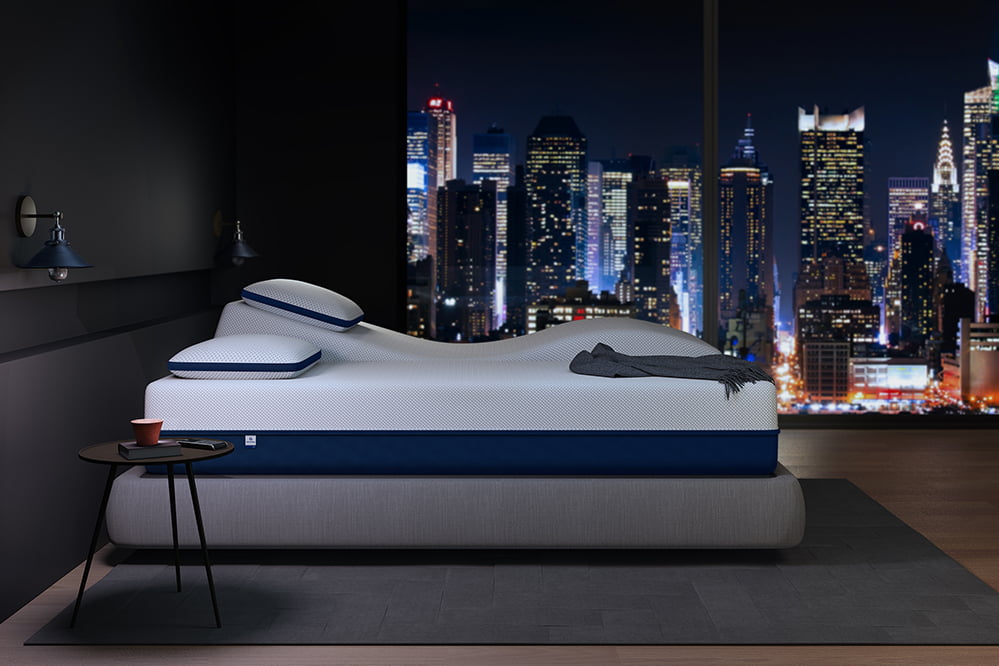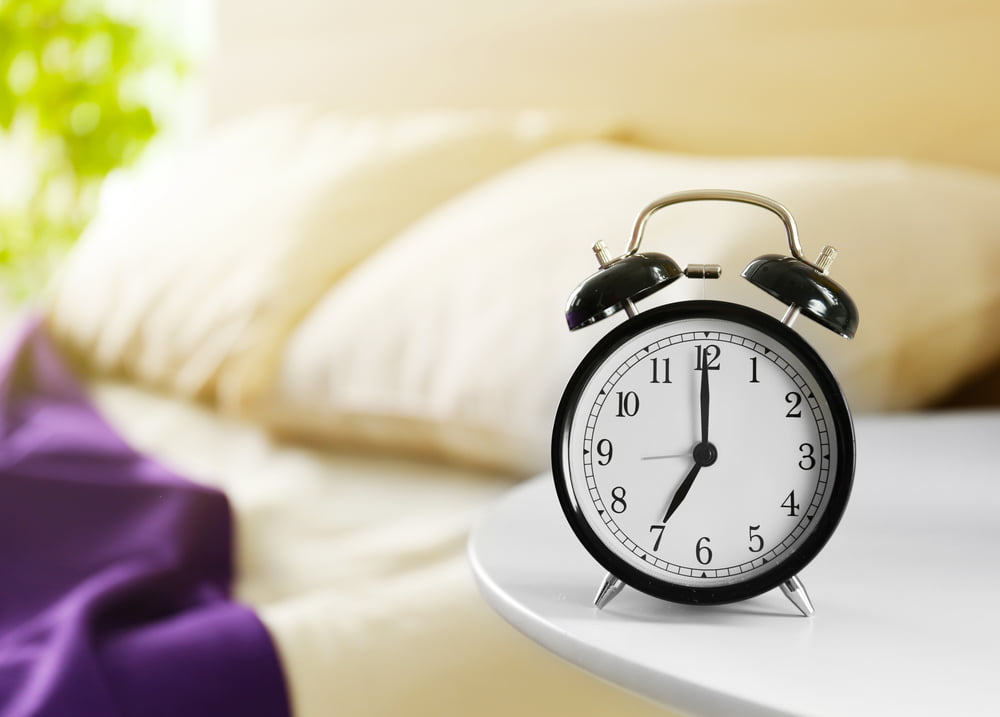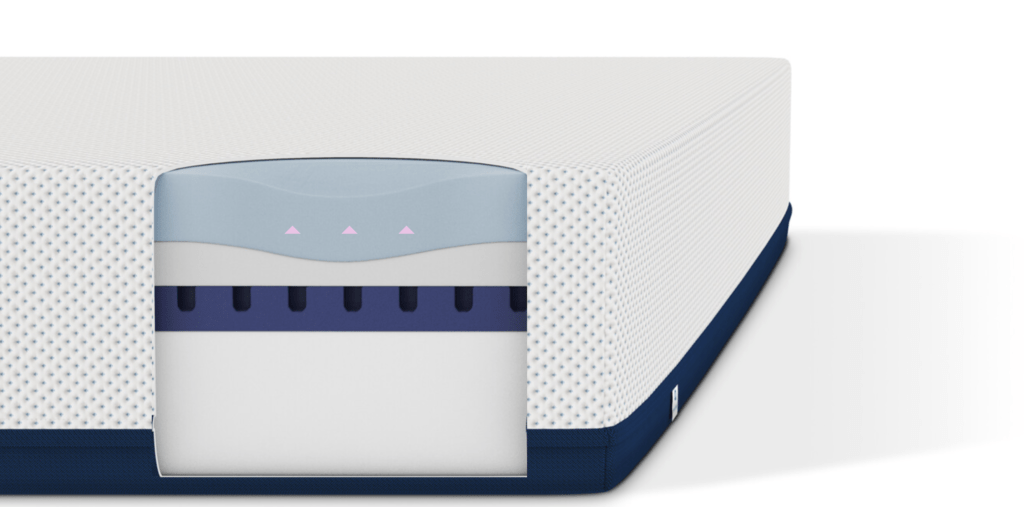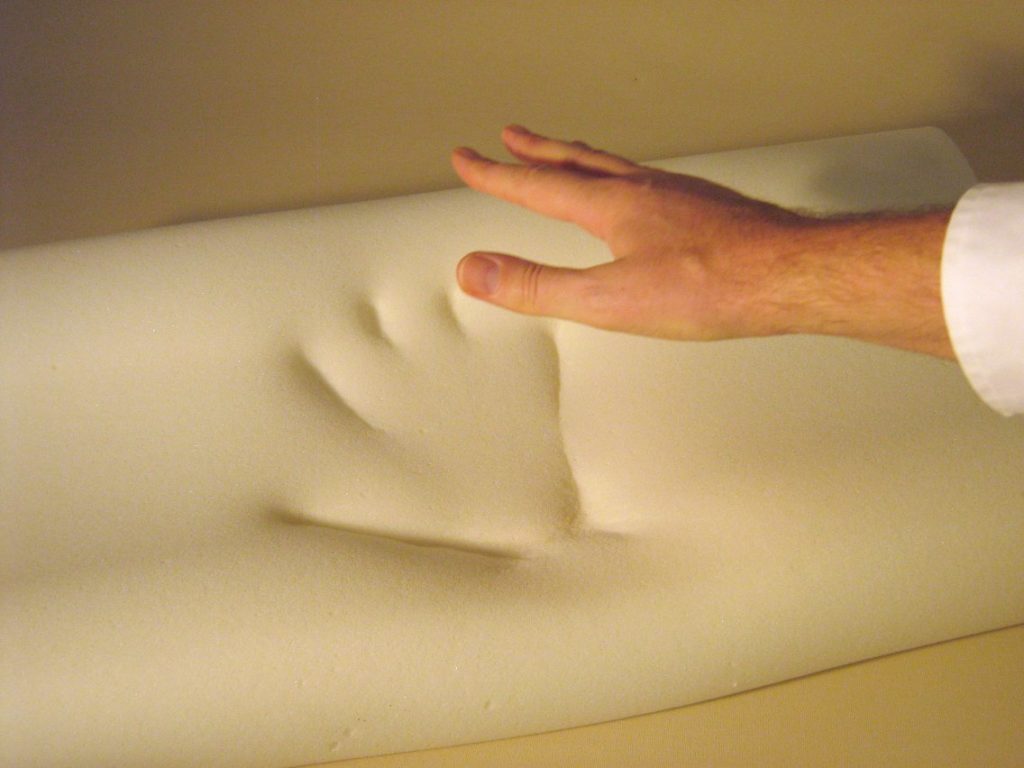New mattress companies keep popping up online. There are countless ads featuring thin men and women lounging on beds that barely bend under their weight. Also, if you visit a store in person, you might be struck by the thin profile of modern mattresses. However, according to the National Institute of Diabetes and Digestive and Kidney Diseases, more than two in three adults were considered overweight or obese in a survey conducted in 2013 and 2014. If you have ever wondered about what’s the best mattress for heavy people, you aren’t alone.
Below we are going to go over what makes a bed good (or not so good) for heavier people. We will go over our what we mean when we say “heavier”, how sleep and weight work together, and the important things to know about mattresses. First, we want to give you five mattresses companies which might work for you if you are looking for the best bed for heavier people.
Five Mattress Companies to Consider

Everybody is different, and that means it can be difficult to make blanket statements about the ideal mattress for a body type. All overweight bodies aren’t the same. The comfort elements you need might be deeply personal. However, after examining information about construction, reviews, and quality, these are five mattress companies that might be right for heavier people.
Amerisleep
Amerisleep offers five firmness levels to suit all different types of bodies. For customers who are looking for the best mattress for heavy people, we recommend their AS2, AS3, and AS5.Amerisleep’s AS2 is a medium-firm option. Medium-firm is often referred to as the best firmness for back pain, which could explain why Business Insider chose Amerisleep’s AS2 as its best mattress for back pain. The Amerisleep AS2 is 12 inches tall and contains 2 inches of plant-based comfort foam, 3 inches of a transitional layer featuring clinically-proven zoned support, and 7 inches of a firm, durable core layer. Amerisleep markets the AS2 as an excellent choice for back and stomach sleepers. This is a great option for heavier sleepers who want a firmer feel.
Amerisleep says their AS3 is made for combo sleepers. The AS3 is also 12 inches tall, but it is made with 3 inches of plant-based comfort foam (vs. the 2 inches found in the AS2) and 2 inches of a transitional layer with clinically-proven zoned support. By being made for combo sleepers, it’s going to work well for stomach, back, and side sleepers. It makes sense Allure listed it as the best mattress to buy online. This is an excellent option for heavier sleepers who want a medium feel.
The AS5 is Amerisleep’s softest mattress. But, it’s a little different than the rest of the mattresses they make. The AS5 is 14 inches thick, and those extra two inches are made of a very bouncy and supportive foam, called Active Flex. Given its height and the density of its foams, this is a great option for customers looking for the best mattress for heavy people and prefer a softer feel.
- Amerisleep’s AS2 is a medium-firm option. Medium-firm is often referred to as the best firmness for back pain, which could explain why Business Insider chose Amerisleep’s AS2 as its best mattress for back pain. The Amerisleep AS2 is 12 inches tall and contains 2 inches of plant-based comfort foam, 3 inches of a transitional layer featuring clinically-proven zoned support, and 7 inches of a firm, durable core layer. Amerisleep markets the AS2 as an excellent choice for back and stomach sleepers. This is a great option for heavier sleepers who want a firmer feel.
- Amerisleep says their AS3 is made for combo sleepers. The AS3 is also 12 inches tall, but it is made with 3 inches of plant-based comfort foam (vs. the 2 inches found in the AS2) and 2 inches of a transitional layer with clinically-proven zoned support. By being made for combo sleepers, it’s going to work well for stomach, back, and side sleepers. It makes sense Allure listed it as the best mattress to buy online. This is an excellent option for heavier sleepers who want a medium feel.
- The AS5 is Amerisleep’s softest mattress. But, it’s a little different than the rest of the mattresses they make. The AS5 is 14 inches thick, and those extra two inches are made of a very bouncy and supportive foam, called Active Flex. Given its height and the density of its foams, this is a great option for customers looking for the best mattress for heavy people and prefer a softer feel.
Saatva
The Saatva mattress may also be a good choice for larger people. Saatva makes three innerspring mattresses, a firm, luxury firm, and a plush. There is a concern about heavier people using innerspring mattresses as there is an increased concern of motion transfer. However, Saatva does use individually wrapped coils to help mitigate that concern. These mattresses contain two separate layers of coils, topped with layers of foam. Their three firmness levels are available in two heights. There is the 11.5” profile and the 14.5” profile. According to Saatva, the main difference is the 14.5” profile is recommended for adjustable beds. However, the Saatva does “take two turns” out to make the thinner profile mattress. Because of this, the 14.5” may be the better choice for heavier customers.
Also, Saatva offers lumbar support in all of their mattresses. That extra support in the lumbar area could be a great benefit for heavier sleepers.
Because all of their mattresses come in the same two heights, Saatva recommends their firm for heavier sleepers.
Winkbed
Winkbeds makes one hybrid mattress in four different firmnesses. One firmness option, the Plus, is specifically designed for heavier people.
The Winkbed Plus contains four layers and is 15 inches thick. The first layer is poly-foam, which Winkbeds refers to as “Body Impression-Proof Foam”. The second layer is a zoned support latex foam. Next, is a zoned layer of individually pocketed coils. Between the latex foam and the coils, this mattress looks designed to provide a significant bounce.
The layer of zoned springs is made to support natural spinal curves without pressing too hard on sensitive areas like the shoulders. The Winkbed Plus also contains gel-infused foam designed to provide cushion and support while moving heat away from the body.
Dreamcloud
The Dreamcloud is a 15-inch thick hybrid mattress. The Dreamcloud consists of seven layers. There are five layers of memory foam and one layer of latex foam. The main support of the Dreamcloud mattress is their “five-zoned foam encased pocketed micro coil” system. Given its thickness, the use of zoned support, the use of latex and memory foam, the Dreamcloud is a good option for heavier sleepers.
Big Fig
The company Big Fig is a market leader for mattresses for larger people. The company claims it was founded to help serve the needs of larger people, and they have created processes and procedures to ensure that the mattresses sold work for those with larger bodies. Mattresses contain 1,600 pocket springs to provide support and cushioning, and the foundation at the base of the mattress is designed to support five times the weight of an average foundation. Engineers also perform durability testing to ensure these mattresses will hold up with use.
Big Fig is unique on our list because it is the only company on our list which designs their mattresses specifically for heavier people.
Defining Our Terms
Weight is not subjective to doctors and scientists. They use very strict rules to help them understand when a person’s weight might be too high. Often, they use a measurement known as body mass index (BMI).
If your score is between 25 and 29, you are considered overweight. If your score is 30 or higher, you are considered obese.
Understanding these scores is important, as the data can help you determine whether or not studies about weight and sleep apply to you, and whether mattresses designed for overweight people are right for you.
Sleep and Your Weight

While you sleep, it may seem as though your body is completely inert and at rest. In reality, there are many key processes taking place, many of which impact your metabolism, and could influence your weight.
- Decreased glucose tolerance.
- Decreased sensitivity to insulin.
- Higher levels of cortisol (a stress hormone) in the evenings.
- Increased levels of ghrelin (often called the “hunger hormone”).
- Decreased levels of leptin (a hormone involved with energy).
These changes could make you feel hungrier for a few reasons. First, they could cause spikes and dips in your energy level, making you hungry. Second, they can also cause your body to gather up energy for future use, leading to weight gain. Third, may also feel less likely to exercise.
These changes are not theoretical. In other studies, researchers have found a clear and persistent link between adults who do not get enough sleep and increased numbers registering on the scale.
According to the T.H. Chan School of Public Health at Harvard, a study of more than 60,000 women lasting for more than 16 years found that people sleeping five hours or less each night had a 30 percent higher risk of gaining 30 pounds over the course of the study, when compared to people who got seven hours of sleep per night.
Studies like this show how getting too little sleep can have a meaningful impact on the numbers you see on the scale. But the numbers you see on the scale can also affect how much you sleep each night.
According to the National Sleep Foundation, respiratory problems during sleep like snoring and sleep apnea are connected to obesity and weight gain. When added tissues collect around the chest and throat, which is common with obesity, airways grow compressed. Each breath is forced through that compressed area, leading to snoring.
Snoring can keep your partner awake, but it can also impact your ability to stay asleep. When your tissues are so compressed that you feel as though you gasp for air, you can awaken in a panic. Some people experience that awakening multiple times throughout the night. This intermittent sleeping does not give you the opportunity to drop into deep, restorative sleep. You can awaken feeling even more tired than you did when you went to bed the night before.
Intermittent sleeping is not just associated with a feeling of exhaustion. According to research published in Obesity: A Research Journal, people who are overweight or obese are more likely to sleep intermittently than people who sleep continuously. This seems to suggest that the metabolic changes that happen with low amounts of sleep are closely tied with broken sleep.
It seems reasonable, as a result, to look for ways to ensure that you are sleeping comfortably throughout the night. Comfort could be the key variable that keeps you in deep layers of sleep, so you can get all the benefits that sleep offers. Choosing the right mattress could be an important part of ensuring your comfort throughout the night.
Mattress Fundamentals to Consider

Mattresses may look very similar. Most have fabric tops, squishy sides, and a vast expanse in the middle. But beneath the covers of those mattresses lies technology, and that technology could be a key part of your sleep comfort.
Mattress engineers can, and often do, design mattresses to benefit a specific sleeping position. They may alter the density or softness of a mattress to help ensure that people who choose to sleep in any particular posture get the most comfort from the mattress they choose.
Mattresses made to support the side-sleeping position might be right for some heavy people. For example, in a study published in Psychiatry and Clinical Neurosciences, researchers asked people with sleep apnea to shift from sleeping on their backs to sleeping on their sides. Among people with mild obesity, 74 percent saw improvement in their symptoms when they shifted to this side-sleeping position.
If you want to move to side sleeping, you need a mattress that offers cushion for the bones in the shoulders and support for the bones in the hips. This structure will help prevent soreness in the shoulder while keeping your spine in a neutral position as you lie on your side. Since snoring and sleep apnea are common in those who are heavy, side-sleeping options could be ideal for people in this group.
People with higher body mass also put more pressure on the mattress when they sleep each night. Thin, soft foams might not retain the ability to bounce back to normal. Thin mattresses might also allow heavier people to sink right through them, which could leave you feeling as though you are sleeping on a very hard, unforgiving surface.
Combining the softness of foam with added elements, such as springs, could help the mattress to hold up to your weight. Those additional elements could also provide the support your bones and joints need.
Do You Need a Test Drive?

Some companies offer you the opportunity to visit a showroom and check out a mattress in person. If you have that opportunity, take these steps to make your visit meaningful:If you routinely sleep with someone else, do your trial on your preferred side of the bed (not the middle).
Climb onto the mattress, and ask a trusted friend to explain how much the mattress has compressed. When you get off the mattress, see how long it takes to spring back.
Lie in your preferred sleeping position for several minutes without talking or moving to assess true comfort.
Examine the construction of the bed and look for signs of showroom wear and tear. You may be able to spot shoddy construction that you could experience at home too.
Be prepared to ask the retail salesperson about the quality of materials, the sleep trial on the mattress, and the warranty.
- If you routinely sleep with someone else, do your trial on your preferred side of the bed (not the middle).
- Climb onto the mattress, and ask a trusted friend to explain how much the mattress has compressed. When you get off the mattress, see how long it takes to spring back.
- Lie in your preferred sleeping position for several minutes without talking or moving to assess true comfort.
- Examine the construction of the bed and look for signs of showroom wear and tear. You may be able to spot shoddy construction that you could experience at home too.
- Be prepared to ask the retail salesperson about the quality of materials, the sleep trial on the mattress, and the warranty.
However, spending 15 minutes on a mattress in a showroom is not a great indicator of whether the mattress will work for you. This is why we see great value in mattress companies which offer a sleep trial. Sleep trials allow you to get your new mattress home and sleep on it in your room for a certain amount of days. We recommend giving a new mattress at least thirty days, as this allows your body and the new mattress to adjust to each other. After 30 nights of sleeping on your mattress, you will have a much better idea if it will work for you. If it doesn’t, a good sleep trial allows for hassle-free returns without any restocking or return fee.
Also, to help you narrow down your choices, we have examined hundreds of mattresses, and the results of our examinations are available on our website. Read our reviews, and you might spot a mattress that is right for you and your body.
We hope to help you get the rest you need and make an informed decision as a consumer. Check out our site to find out more.
Sources
Overweight and Obesity Statistics. (August 2017). National Institute of Diabetes and Digestive and Kidney Diseases.
Normal Weight Ranges: Body Mass Index (BMI). (February 2016). American Cancer Society.
Sleep and Obesity. (April 2013). Current Opinion in Clinical Nutrition and Metabolic Care.
Sleep Deprivation and Obesity. T.H. Chan School of Public Health at Harvard.
Obesity and Sleep. National Sleep Foundation.
Sleep Duration and Quality Associated with Obesity Among Arab Children. (September 2012). Obesity: A Research Journal.
The Influence of Sleep Position and Obesity on Sleep Apnea. (June 2000). Psychiatry and Clinical Neurosciences.
This article is for informational purposes and should not replace advice from your doctor or other medical professional.




The Conversation (0)
Start a discussion, our content team tries our best to respond to comments. However replies should not be a substitute for medical advice from your doctor.*